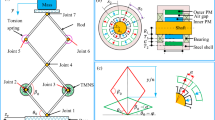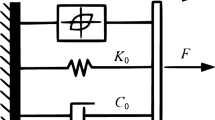Abstract
Application of saturation to provide active nonlinear vibration control was introduced not long ago. Saturation occurs when two natural frequencies of a system with quadratic nonlinearities are in a ratio of around 2:1 and the system is excited at a frequency near its higher natural frequency. Under these conditions, there is a small upper limit for the high-frequency response and the rest of the input energy is channeled to the low-frequency mode. In this way, the vibration of one of the degrees of freedom of a coupled 2 degrees of freedom system is attenuated. In the present paper, the effect of dry friction on the response of a system that implements this vibration absorber is discussed. The system is basically a plant with a permanent magnet DC (PMDC) motor excited by a harmonic forcing term and coupled with a quadratic nonlinear controller. The absorber is built in electric circuitry and takes advantage of the saturation phenomenon. The method of multiple scales is used to find approximate solutions. Various response regimes of the closed-loop system as well as the stability of these regimes are studied and the stability boundaries are obtained. Especial attention is paid on the effect of dry friction on the stability boundaries. It is shown that while dry friction tends to shrink the stable region in some parts, it enlarges other parts of the stable region. To verify the theoretical results, they have been compared with numerical solution and good agreement between the two is observed.
Similar content being viewed by others
References
1. Nayfeh, A. H., Nonlinear Interactions, Wiley-Interscience, New York, 2000.
2. Lefschetz, S., ‘Linear and nonlinear oscillations’, in Modern Mathematics for the Engineer, E. F. Beckenback (ed.), McGraw-Hill, New York, 1956.
3. Froude, W., ‘Remarks on Mr. Scott Russell's paper on rolling’, Transactions of the Institute of Naval Architects 4, 1863, 232–275.
4. Nayfeh, A. H., Mook, D. T., and Marshall, L. R., ‘Nonlinear coupling of pitch and roll modes in ship motion’, Journal of Hydronautics 7, 1973, 145–152.
5. Tuer, K. L., Golnaraghi, M. F., and Wang, D., ‘Development of a generalized active vibration suppression strategy for a cantilever beam using internal resonance’, Nonlinear Dynamics 5, 1994, 131–151.
6. Golnaraghi, M. F., ‘Regulation of flexible structures via nonlinear coupling’, Journal of Dynamics and Control 1, 1991, 405–428.
7. Khajepour, A., Golnaraghi, M. F., and Morris, K. A., ‘Theoretical development of a nonlinear modal coupling controller for forced vibration applications using normal forms’, in Proceedings of the 32nd Annual Technical Meeting of the Society of Engineering Science, New Orleans, LA, 1995, pp. 263–364.
8. Salemi, P., Golnaraghi, M. F., and Heppler, G. R., ‘Control of forced and unforced structural vibration using a linear coupling strategy’, in Proceedings of the 32nd Annual Technical Meeting of the Society of Engineering Science, New Orleans, LA, 1995, pp. 221–222.
9. Oueini, S. S., Nayfeh, A. H., and Golnaraghi, M. F., ‘A theoretical and experimental implementation of a control method based on saturation’, Nonlinear Dynamics 13, 1997, 189–202.
10. Shoeybi, M. and Ghorashi, M., ‘Saturation and its applications in the vibration control of non-linear systems’, in Proceedings of ESDA, 7th Biennial Conference of Engineering Systems, Design, and Analysis, Manchester, UK, July 19–22, 2004, ESDA 2004-58297.
11. Shoeybi, M. and Ghorashi, M., ‘Control of a Nonlinear System Using the Saturation Phenomenon’, in Nonlinear Dynamics 42, 2005, 113–136.
12. Nayfeh, A. H., Introduction to Perturbation Techniques, Wiley-Interscience, New York, 1981.
13. Nayfeh, A. H. and Mook, D. T., Nonlinear Oscillations, Wiley-Interscience, New York, 1979.
14. Tondl, A., Ruijgrok, T., Verhulst, F., and Nabergoj, R., Auto-Parametric Resonance in Mechanical Systems, Cambridge University Press, Cambridge, 2000.
15. Thomsen, J. J., Vibrations and Stability — Order and Chaos, McGraw-Hill, London, 1997.
16. Ogata, K., Modern Control Engineering, Prentice Hall, New Jersey, 2002.
Author information
Authors and Affiliations
Corresponding author
Additional information
This work was done while the authors were associated with the Mechanical Engineering Department, Sharif University of Technology, Tehran, Iran.
Rights and permissions
About this article
Cite this article
Shoeybi, M., Ghorashi, M. Nonlinear Vibration Control of a System with Dry Friction and Viscous Damping Using the Saturation Phenomenon. Nonlinear Dyn 45, 249–272 (2006). https://doi.org/10.1007/s11071-006-1438-2
Received:
Accepted:
Published:
Issue Date:
DOI: https://doi.org/10.1007/s11071-006-1438-2




